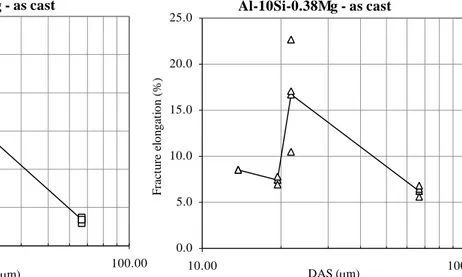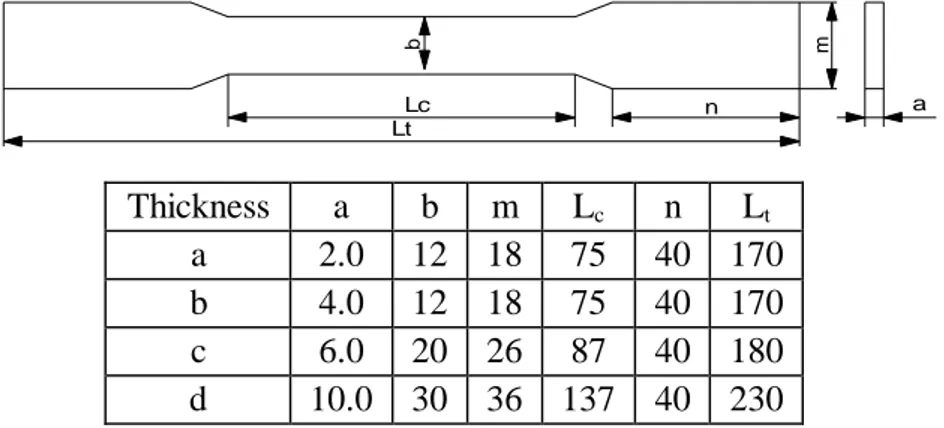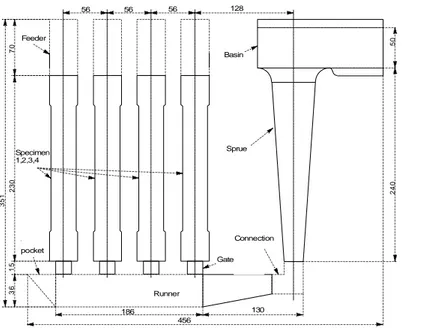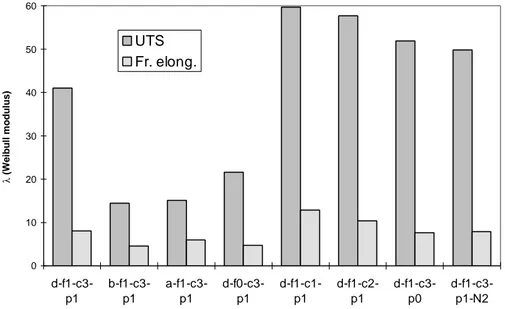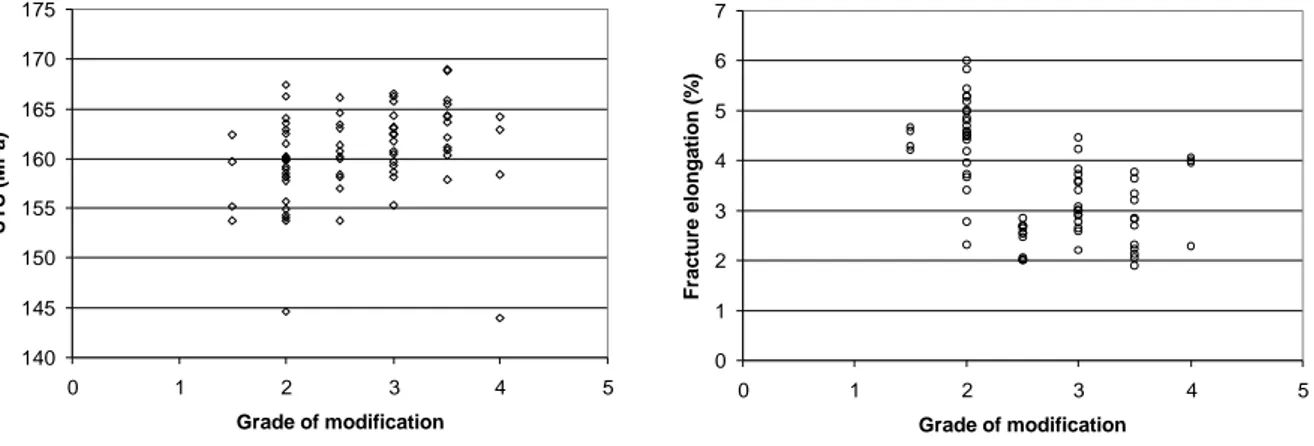Influence of Ingate System Design on Mechanical Properties of a
Cast Al - 10Si – 0.38Mg Alloy
Jonas Bäckman and Ingvar L Svensson Div. of Component Technology
School of Engineering Jönköping University, SWEDEN
KEYWORDS
Ingate system, Mechanical properties, Mould filling, Weibull modulusABSTRACT
In this work the influence of the ingate system design on the as-cast mechanical properties of an Al-10Si-0.38Mg alloy have been clarified. The Weibull distribution has been seen to describe the spread in mechanical properties very well. The Weibull modulus has therefore been used as a measure of the soundness of an ingate system. Different ingate systems were investigated, including: expanding systems, pressurised systems, systems with and without filter, systems with different designs of the connection between the downsprue and the runner, and systems with and without an additional pocket at the end of the runner. The modification index of the microstructure was also measured in order to investigate if the spread in data is more dependent on the modification index than on the ingate system design. The results showed that a high Weibull modulus is more dependent on the ingate system design than on the modification index of the microstructure. The ultimate tensile strength was not significantly affected by the ingate system design, while the fracture elongation seemed to be more dependent on the melt quality than on the ingate system design. The Weibull modulus indicates that expanding systems are better than pressurised systems, and that the use of a filter in the runner is very beneficial. An additional pocket at the end of the runner has no beneficial effect when using a filter. The connection between the downsprue and the runner should have a rounded bend and the change in cross-section between the downsprue and the runner should be chamfered and not sharp.
1 INTRODUCTION
High reliability aluminium alloy castings are obtained by bottom filling a sand mould at an initial melt ingate velocity less than a critical value. This critical value is connected with the surface turbulence of the liquid. Earlier studies[1-3] have pointed out that a high metal velocity, and surface turbulence affect the quality of cast aluminium alloys. When the melt reaches a velocity of 0.5 m/s the liquid front becomes unstable and oxide entrainment occurs, leading to folded oxides to oxide film filling defects. Exceeding this critical velocity during bottom filling, or top pouring a distance of more than 12.5 mm, results in conditions of surface turbulence. It is quite obvious that it is almost impossible to keep the velocity below the critical 0.5 m/s during the filling of the ingate system. Even if the filling is turbulent only during the filling of the ingate system, and the filling of the casting is free from turbulence, the result will still be entrained oxide films in the casting. The main task is therefore not only to design the ingate system to reduce the velocity of the melt and keep it below 0.5 m/s when it reach the gates, but also to design the component parts of the ingate system in such a way as to prevent melt quality deterioration during the filling.
Recently, some direct observation experiments have been made in order to clarify the effect of component parts and filter conditions on mould filling behaviour in vacuum-sealed sand moulds[4-5]. However, the effect of component parts on mould filling behaviour and the corresponding effect on mechanical properties has not previously been quantified.
When the mechanical properties of a set of specimens are measured, the results are usually distributed about some mean value. The exact nature of the distribution is often unclear. The spread in mechanical properties due to microstructure variations has been discussed elsewhere[6, 7]. Previous studies[8, 9] have found that the Weibull distribution most accurately describe the spread of the tensile properties.
The aim of this investigation is to quantify how different component parts and their design influence the mechanical properties using the Weibull approach. Different types and shapes of component parts will produce different levels of oxide film filling defects. More filling defects means more defects larger than the critical size at a given stress and, therefore, the probability of failure increases.
2 POTENTIAL IN MECHANICAL PROPERTIES
The alloy used in this work have been investigated earlier in a gradient solidification equipment, where the mechanical properties have been determined[10]. The alloy was re-melted and solidified in a well defined temperature gradient which gives a good feeding of the material, and the solidified metal is free from shrinkage porosity and oxide films from the filling process. The result from such a processing can be used as a measure of the optimal mechanical properties at a given solidification rate. The ultimate tensile strength and the fracture elongation are shown in figure 1 and figure 2 at different solidification rates. As a measure of the solidification rate the secondary dendrite arm spacing (DAS) was used.
Figure 1. UTS at different DAS. Figure 2. Fracture elongation at different DAS.
3 WEIBULL DISTRIBUTIONS
To describe data that are skewed about their mean value, the Weibull distribution is often used. This can be summarised in the two-parameter form as:
where Fw is the fraction of specimens failed at or below a given value of x, e.g. a measured
ultimate tensile strength (UTS), σ is a characteristic value of x at which 62.8% of the Al-10Si-0.38Mg - as cast 150 170 190 210 230 250 270 10.00 100.00 DAS (µm) UTS (MPa) Al-10Si-0.38Mg - as cast 0.0 5.0 10.0 15.0 20.0 25.0 10.00 100.00 DAS (µm) Fracture elongation (%) λ σ −
−
=
x we
F
1
population of specimens have failed and λ is the Weibull modulus. The value of λ is obtained as the slope of the straight line when plotting ln[ln(1/1-Fw)] vs. ln(x). The greater the value of
λ, the narrower is the range of the data.
4 EXPERIMENTAL
Flat-bar Al-10Si-0.38Mg alloy test specimens, with dimensions according to figure 3, were vertically cast in vacuum-sealed silica sand moulds using a variety of shapes of component parts for the ingate system. The casting conditions and subsequent abbreviations used in the text are listed in table 1. The basic geometry is designed for a non-pressurised or expanded gating system (i.e. sprue: runner: gate = 1.2: 2: 4). Experiment 4-6, i.e. specimens of thickness 4 mm were cast using an ingate system with ratios. 1.2: 2: 1.6 and experiment 7-9, i.e. specimens of thickness 2 mm were cast with the ratio 1.2: 2: 0.8 for sprue: runner: gate areas.
Lt Lc b n m a Thickness a b m Lc n Lt a 2.0 12 18 75 40 170 b 4.0 12 18 75 40 170 c 6.0 20 26 87 40 180 d 10.0 30 36 137 40 230
Figure 3. Dimension and shape of specimens.
Table 1. Ingate system conditions
Component parts Geometry Explanation Specimen thickness a, b, d thickness
Filter f0, f1 f0=without/f1=with filter
Pocket p0, p1 without/with pocket
Connection c1, c2, c3 see Figure 4
The investigation was constructed using eight different ingate geometries, as listed in table 2 below. Four different parameters were investigated, i.e. different thickness of specimens, with and without filter, with and without an additional pocket at the end of the runner, and three
different types of connections between downsprue and runner. The original type of ingate system geometry was d-f1-p1-c3 (thickness d=10mm, f1=with filter, p1=with pocket and
c3=connection no. 3). In the other experiments only one parameter was changed from the
original geometry. Each geometry was cast three times in order to develop reliable statistics. All filters used were the reticulated foam type with pore size 30 ppi, thickness 22 mm and active area equal to the runner cross-section area. The location of the filter was based on results from earlier work[4] and was placed in the runner immediately after the transition from the sprue to the runner. In the last experiments nitrogen, N2-gas was flushed backwards
through the feeders into the cavity in order to reduce the oxygen content in the cavity atmosphere during mould filling.
All castings were poured at a casting temperature in the range of 720-730°C. The filling procedure started when the stopper was removed from the top of the downsprue in the pouring basin when the basin was filled. The melt was degassed, modified with Na and grained refined with Al-Ti-B additive. The composition of the alloy is listed in table 3. After casting, four test-bars from each experiment and each geometry were investigated by x-ray, in order to investigate differences in inclusions and macroporosities. One test bar from each experiment was examined under an optical microscope in order to measure the modification index of the Al-Si eutectic microstructure, using the AFS proposed standards of modification index.
Table 2. The experimental series.
Experiment no. Geometry
1-3 d-f1-C3-p1 4-6 b-f1-C3-p1 7-9 a-f1-C3-p1 10-12 d-f0-C3-p1 13-15 d-f1-C1-p1 16-18 d-f1-C2-p1 19-21 d-f1-C3-p0 22-24 d-f1-C3-p1-N2 79 R 15 22 130 3 6 22 3 6 130 5 1 22 22 79 130 5 1 2 2 3 6 C o n n e c ti o n c1 c2 c3
Figure 4. Connection parts between down-sprue and runner.
Table 3. The chemical composition of the aluminium alloy used in the present work (before refinement with Al-Ti-B and modification with sodium).
Si Mg Fe Cu Mn Ni Zn Pb Sn Ti Al 10.06 0.38 0.36 0.07 0.27 0.01 0.14 0.02 0.00 0.01 Bal. 56 56 56 128 7 0 2 3 0 1 5 3 6 3 5 1 186 130 456 5 0 2 4 0 Basin Sprue Connection Runner Gate Feeder Specimen 1,2,3,4 Well pocket
Figure 5. Cavity shape (geometry d-f0-p1-c2). Figure 6. 3D-view of cavity (geometry d-f1-p1-c3).
5 EXPERIMENTAL RESULTS
The as-cast ultimate tensile strength and fracture elongation as well as the Weibull modulus for the different geometries were evaluated by tensile testing, the results of which are listed in table 4. The results are based on 12 specimens for each ingate system geometry. The correlation coefficients, r, from the linear regression of the Weibull modulus are also given.
Table 4. Results from tensile testing and Weibull evaluations.
Geometry UTS±std. dev. Fr. elong. Weibull modulus Correlation-coeff. designation [MPa] A25mm[%] λUTS. λA25mm r (UTS) r (A25mm)
d-f1-c3-p1 160±4,3 4,9±0,7 41,0 8,0 0,95 0,98 b-f1-c3-p1 188±13,5 6,7±1,3 14,4 4,5 0,90 0,84 a-f1-c3-p1 171±12,7 4,8±0,9 15,1 5,9 0,96 0,96 d-f0-c3-p1 159±7,6 3,5±0,7 21,6 4,7 0,89 0,90 d-f1-c1-p1 159±2,8 4,6±0,4 59,7 12,9 0,91 0,86 d-f1-c2-p1 162±3,1 3,3±0,3 57,7 10,4 0,97 0,90 d-f1-c3-p0 161±3,5 2,4±0,3 51,9 7,6 0,99 0,85 d-f1-c3-p1-N2 163±3,6 2,4±0,3 49,9 7,9 0,94 0,93
In figure 7 the statistical distribution of the tensile strengths for the specimens from casting geometry d-f1-c3-p1 is shown.
Figure 7. Statistical distribution of fracture strengths for the casting geometry d-f1-c3-p1. 0,0 10,0 20,0 30,0 40,0 50,0 60,0 70,0 80,0 90,0 100,0 150 152 154 156 158 160 162 164 166 168 170 UTS [MPa] Fraction to fracture [%] -3 -2 -1 0 1 2 3 5 5,03 5,06 5,09 5,12 5,15 ln UTS ln(ln(1/1-Fw))) d-f1-c3-p1 λ=41,0 r=0,95
In figure 8 the UTS and fracture elongation are compared for the different ingate system geometries, and in figure 9 the corresponding Weibull moduli are compared.
Figure 8. The UTS and fracture elongation obtained for different ingate geometries.
Figure 9. The Weibull modulus for the UTS and the fracture elongation.
A visual inspection of the x-ray images gave no indication of any significant changes in levels of macro-inclusions in the specimens cast with different ingate systems.
The results from the optical microscope examinations were evaluated in terms of modification index using the AFS proposed standards, and are shown in table 5.
0.0 1.0 2.0 3.0 4.0 5.0 6.0 7.0 d-f1-c3-p1 b-f1-c3-p1 a-f1-c3-p1 d-f0-c3-p1 d-f1-c1-p1 d-f1-c2-p1 d-f1-c3-p0 d-f1- c3-p1-N2 Fracture elongation, A5 (%) 0 20 40 60 80 100 120 140 160 180 d-f1-c3-p1 b-f1-c3-p1 a-f1-c3-p1 d-f0-c3-p1 d-f1-c1-p1 d-f1-c2-p1 d-f1-c3-p0 d-f1- c3-p1-N2 UTS (MPa) 0 10 20 30 40 50 60 d-f1-c3-p1 b-f1-c3-p1 a-f1-c3-p1 d-f0-c3-p1 d-f1-c1-p1 d-f1-c2-p1 d-f1-c3-p0 d-f1-c3-p1-N2 λ (Weibull modulus) UTS Fr. elong.
Table 5. The modification index for different experiments.
Experiment no.
1 2 3 4 5 6 7 8 9 10 11 12 13 14 15 16 17 18 19 20 21 22 23 24 2 2 2 3 3 3. 3 3 3 3 2 4 1. 2 2 3. 3 3 2. 2. 2. 3. 3 3.
The UTS and fracture elongation were plotted as function of modification index for all specimens with thickness 10 mm, which are shown in figure 10 and figure 11 respectively.
Figure 10. The UTS for different modifications. Figure 11. The fracture elongation for different modifications.
The DAS was also measured for the different specimen thickness, and are given in table 6.
Table 6. The DAS for different specimen thickness used in the experiments.
Specimen thickness [mm] Average DAS [µm] Interval DAS [µm]
10 35 30-40
4 20 18-23
2 15 13-16
6 DISCUSSION
The intention of this work was to quantify the influence of ingate system design on the mechanical properties and the reproducibility of the results. As mentioned above, the ingate system was designed as a non-pressurised system for all experiments with specimen thickness 10 mm, while the experiments with specimen thickness 2 and 4 mm were pressurised systems.
140 145 150 155 160 165 170 175 0 1 2 3 4 5 Grade of modification UTS (MPa) 0 1 2 3 4 5 6 7 0 1 2 3 4 5 Grade of modification Fracture elongation (%)
The ultimate tensile strength increased when the specimen thickness was decreased from 10 mm to 4 mm, due to the increased solidification rate which results in decreased DAS. When decreasing the thickness further to 2 mm the DAS was also decreased, but the UTS was not further increased. The ingate system were more pressurised when casting the 2 mm thick specimens compared to the ingate system used when casting the 4 and 10 mm thick specimens. A pressurised system leads to an increase of the melt velocity through the system, which can result in more surface turbulence and an increased risk of air and oxide film inclusions. The decrease in UTS and fracture elongation when decreasing the specimen thickness from 4 to 2 mm can be explained by the increased melt velocity and indirectly by larger amounts of oxide film inclusions. When comparing the Weibull modulus for the experiments with different specimen thicknesses it is very clear that the spread of the tensile results is larger for the more pressurised ingate systems.
When comparing the strengths of the 10 mm thick specimens cast with different ingate system designs the mean values of the UTS for each geometry are not significantly affected. The mean UTS values at each geometry are all in the range of 159-163 MPa. The corresponding mean values of the fracture elongation are on the other hand quite different.
When excluding the filter from the ingate system the fracture elongation decreased and the spread in data was significantly increased. The Weibull modulus was reduced by a factor of almost two. The filter has, from the authors’ point of view, one predominant effect, which is to reduce the velocity of the melt. The filtration effect or inclusion removal by the filter has not been investigated in detail, and is assumed to be less effective in increasing the quality of the casting as compared to the reduction of melt velocity. The reduced velocity of the melt gives a faster filling of the ingate system before the filter and less surface turbulence after the filter.
The ingate systems with filter and specimen thickness 10 mm are all good systems and all have a Weibull modulus above 40 for the UTS. They can in other words be said to be reproducible systems. The best system is the one with connection no. 3, i.e. a rounded bend and a chamfered section to the runner. Connection no. 2, i.e. a perpendicular bend and a chamfered cross-section to the runner also increased the Weibull modulus compared to the results with connection no. 1.
The additional pocket at the end of the runner seems to have a positive effect on mechanical properties, especially the fracture elongation, while the Weibull modulus increased when no pocket was present.
The use of N2 gas flushed backwards through the ingate system before and during the filling
had no positive effect on the mechanical properties but increased the Weibull modulus slightly.
The modification index has been investigated for all the cast specimens, and when plotting the UTS versus modification index, and regarding the ingate system used, a slight improvement of the UTS can be seen as the modification index increases. When doing the same analysis with the fracture elongation and modification index, the opposite relation occurs, which means that a slight decrease in fracture elongation can be seen when the modification index increases. One explanation of this may be hydrogen pick-up from the surroundings due to the modification processing which caused an increase in gas porosity in the solidified metal.
The mechanical properties of cast aluminum alloys are influenced by many factors, such as chemical composition, cooling conditions, melt soundness and casting conditions. By casting conditions is meant the pouring of the metal from the melt furnace to the mould cavity. The melt cleanness is very hard to measure, and could be dramatically changed when the melt is degassed or modified with for example sodium salts. The mechanical properties can in other words be dramatically changed from one day to the next. To measure the reproducibility of the mechanical properties for specimens cast with different ingate systems the Weibull modulus was used. The melt was not treated until the ingate system was changed and the melt quality was therefore assumed to be the same for each experiment with the same ingate system. The Weibull modulus is therefore assumed to be a better measure of how good the ingate system is. A better ingate system gives more reproducible properties.
The UTS and fracture elongation for the 10 mm thick specimens with DAS = 35 µm should be 200 MPa and 12% respectively according to the as-cast mechanical properties achieved by gradient solidification, presented in figures 1 and 2 above. The best result from the present experiments gave UTS = 160 MPa and fracture elongation = 5 %.
From this it can be concluded that the casting process can be further improved to reach these properties.
7 CONCLUSIONS
The influence of ingate system design on as-cast mechanical properties has been clarified. The Weibull distribution has been shown to describe the spread in mechanical properties very well.
Pressurised systems increase the spread of data and the Weibull moduli are strongly reduced.
The use of a filter in the runner directly after the downsprue increases the Weibull modulus significantly.
A connection with a rounded bend and a chamfered cross-section to the runner is better than a connection with a perpendicular bend and an immediately change in cross-section between the downsprue and the runner.
An additional pocket at the end of the runner is not beneficial when using a filter.
A well modified microstructure will slightly improve the UTS but in turn decrease the fracture elongation slightly. The Weibull modulus is more dependent on the ingate system design than on the modification index of the microstructure.
The casting process can be further improved to obtain even better mechanical properties.
8 ACKNOWLEDGEMENT
The authors would like to thank the staff of Saab Training Systems AB for their help with the preparation and the accomplishment of the experiments, and for their financial support of this work. We would also like to thank Mikael Cederfeldt for his help with the preparation and optical photographing of the polished specimens. Last but not least the KK-foundation is greatly acknowledged for their financial support of this work.
9 REFERENCES
[1] Runyoro J. J., Boutarabi S. M. A. and Campbell J., “Critical gate velocity for
film-forming casting alloys: a basic for process specification”, AFS Trans., Vol.
104 (USA), pp. (1997)
[2] Sirrell B. and Campbell J., “Mechanism of filtration in reduction of casting
defects due to surface turbulence during mould filling”, AFS Trans., Vol. 105
(USA), pp. 645-654, (1998)
[3] Green N. R. and Campbell J., “Influence of oxide film filling defects on the
strength of Al-7Si-Mg alloy castings”, AFS Trans., Vol. 102, pp. 341-347,
(1994)
[4] Bäckman J., Svensson I. L and Maeda Y., “Mould filling observations of
aluminium melts in vacuum sealed sand moulds”, (to be published), Jönköping
University, Sweden, (1999)
[5] Bäckman J., Svensson I. L and Maeda Y., “Influence of filter on the mould
filling of aluminium melts in vacuum-sealed moulds”, (to be published),
Jönköping University, Sweden, (1999)
[6] Hafiz M. F. and Kobayashi T. “Fracture toughness of eutectic Al-Si casting alloy
with different microstructural features”, Journal of Materials Science (UK), 31,
(23), pp. 6195-6200, 1 Dec. (1996)
[7] Dighe M. D. and Gokhale A.M., “Relationship between microstructural
extremum and fracture path in a cast Al-Si-Mg alloy”, Scripta Materialia (USA),
37, (9), pp.1435-1440, 1 Nov. (1997)
[8] Green N. R. and Campbell J., “Statistical Distributions of Fracture Strengths of
Cast Al-7Si-Mg Alloy”, Materials Science and Engineering, A173, pp. 261-266,
(1993)
[9] George R. D. and Keegan N. J., “Filtration of aluminium-a Weibull statistical
approach to the analysis of mechanical properties”, Foundry Practice, 226, pp.
14-17, July (1995)
[10] Bäckman J. and Svensson I. L., “Potential for improved mechanical properties
in cast aluminium alloys”, Submitted to the Int. J. of Cast Metals Research.
